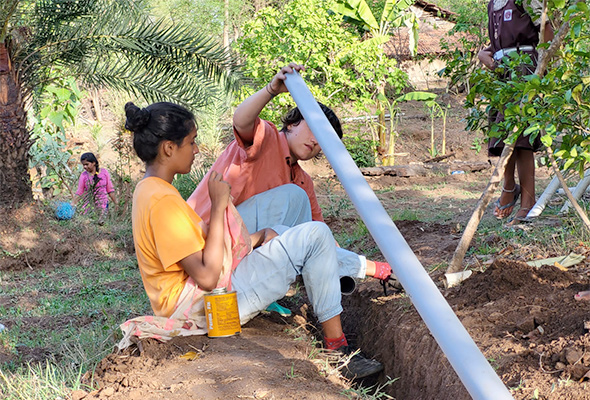A Drop For Growth
Installing drip irrigation systems into two farms in rural Maharashtra, in a region called Palghar. The money from the grant covered the upfront costs of the drip irrigation equipment, such as a tank and PCV pipes.
| Project Title | A Drop For Growth |
|---|---|
| Year | |
| Lead Name(s) |
Background

“When we arrived, we knew that our priority was providing assistance specific to each farmer, something which required constant communication. Each of the farms had different needs, be it a reliable water source or a means to irrigate crops after the Monsoon season, and we did our best to adapt to these needs within our budget.
“In the first farm, we arranged for a borewell to be dug to provide a groundwater source, and then had this connected to an extensive drip irrigation system that meant that the farmer could utilise his land better, creating more revenue and food security for himself and his family. With the second family,we had a similar task, and collaborated with the family to provide drip irrigation throughout their plot of land, which would reduce their water use. We were happy that we were able to do this, as the specified watering of a drip irrigation system – rather than flood irrigation – is much more suited to the long dry season in India and ensures that no strain is put on either the water source or the crops.
“Additionally, less dependency on the monsoon season creates a more reliable way of farming, especially with increased weather unpredictability due to climate change. Working with the third farm, it quickly became apparent that it was not an irrigation system they needed, but just a constant water source.”
Mission Statement
“When we won the grant, we had set out to install drip irrigation systems into two farms in rural Maharashtra, in a region called Palghar. The money from the grant covered the upfront costs of the drip irrigation equipment, such as a tank and PVC pipes. To widen the scope of the project, we also set up a crowdfunding page, and the money raised from this allowed us to expand to another farm.”
How the Funding Was Used
“Overall, our biggest costs went towards the digging of the boreholes and installation of the electric pumps; however, without these, the drip irrigation system wouldn’t have provided its purpose of creating less weather dependency.”
How The Project Made A Difference for the Volunteers
“As a team, this project had a lasting impact on all of us. Aside from the increased organisational skills that came with the necessity of tight budgeting and time management, our problem solving skills improved massively, as well as our perseverance towards issues which didn’t seem to have a straightforward answer. We learnt an invaluable amount from the people we were lucky enough to collaborate with – the farmers, their families, and the nuns provided fresh perspectives and insight that we are very grateful for.
“In hindsight, if we were to run the project again, we would pay more consideration for the timing of the project; the looming monsoon meant that the preparatory work had to be done quickly and also its arrival created several ‘lost’ days since the rains were too torrential to work in. However, these days also had their value, as we assisted the nuns in the running of their community college and kept up contact with the farmers.
“All in all, we are very grateful to have had this opportunity to make a difference, thanks to the generous funding and vision of Jill and Colin.”

Quote
It felt incredible to be able to put our UWC education into practice and make the theory a reality; this project has taught us that this is possible.
